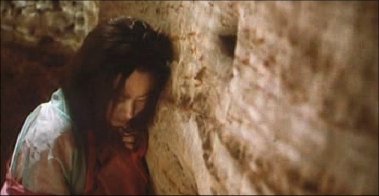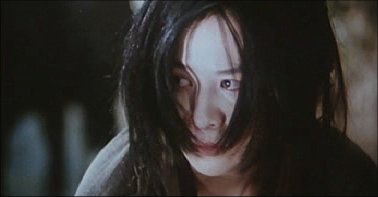|
Text and layout © Ed Shum, 2003. Ed Shum asserts the moral right to be identified as the author of this work |
|
Long Reviews |
|
It is in the second half of the film that Leslie Cheung’s character becomes more carefully shaded for the viewer, as we glimpse his past, his aspirations, motivations and changes. This doesn’t mean that the earlier parts of the film show a two dimensional character: far from it, the depiction of the present guise of ‘Malicious West’ forms a characterisation richer than most films can ever approach. His cynicism, aloofness and cool (given a brilliant multi-layered portrayal by Leslie Cheung) perfectly counterpoints the various characters who come across him with their own problems, drives, desires and memories. He supposedly helps people ‘solve their problems’ by hiring killers for them, in the process learning just why they are so hurt. We see him as a middle man between the problems of others, but hints arise as to his own pain, a pain so great that he can’t bear anyone else being happy. But as of yet we know only his projection in the present, his past and motivation being matters merely of speculation. Later on in the film, he comes across a young swordsman (Jacky Cheung) who seems so unlike him in terms of outlook and motivation. He tries to mould the swordsman into the formula which he has adopted by habit - ironically forcing him to wear shoes and selling him on the basis of his shoes rather than on his tremendous martial ability (in a scene where the subtitles completely misrepresent the dialogue) - and so the swordsman’s standout abilities are muted, taking second place to the image which Leslie Cheung chooses to project. |
|
Review of Ashes Of Time (1994) |
|
|
|
...Continued... [Page 2] |
|
End |
|
In the end, the swordsman rebels against Leslie Cheung’s cynical values, and decides to work by intuition towards the future instead of dwelling on the pains of the past. He rallies against convention and takes his wife adventuring with him - and so we learn of Leslie Cheung’s pain. We learn that he felt he had to leave Maggie Cheung, and we also feel his envy at the swordsman’s choice. Eventually we get the confused, scatty flashbacks of his past: his choice, regrets, late attempts to reconsider, a flurry of jump cuts reflecting the painfully torn memories, recalled in flashes of heightened emotion. In relation to this he, like so many other characters, is stuck in the present in a state of near paralysis, stuck in an existential dilemma, the events, emotions and choices of the past locking him in a routine without fulfilment. This emphasis on being locked in habit reflects Tony Leung Chiu-Wai in Chungking Express, and both leads in In The Mood For Love as well as Maggie Cheung in Days of Being Wild. In Ashes Of Time, finally it takes news of Maggie Cheung’s death to make Leslie Cheung realise that to forget her is impossible. She is in the past and irrecoverable: his memories of her (and their legacy via an offspring?) are all that remain. And so, not healed, restored or redeemed, nevertheless he breaks his routine (and burns down the inn) to move on. |
|
Having said all the above, analysis is something which perhaps doesn’t represent Ashes Of Time too well. Admittedly, especially on first time viewing, much of the film can be impenetrable, frustrating those who seek linear plot development and narrative. Like many of Wong Kar Wai’s films, the communication to the audience, rather than being via traditional linear narrative, works on ‘nodes’ of understanding which we recognise either by their sensory texture (setting or sound for example), by physical presence (objects seen or felt) or by conceptual reference to abstract ideas or conceits. These spread within the film like a web, by which we get perhaps to feel the texture before understanding what (usually minimal) narrative there is. And these nodes become lodged in our mind, perhaps by aesthetic significance or because they actually do connect at an emotional level. This may sound strange when we may only be talking of a spinning bird cage, a particular shot of an oasis or talk of peach blossoms, but their significance is that we remember, and so we are at least in some way inside the story. |
|
Time and tide: another remarkable, abbreviated performance comes from Carina Lau, spending less than five minutes on screen (including two minutes ‘horse-time’) in a pool of water. Yet, via suggestion this becomes a heartfelt, moving story |
|
Because Ashes Of Time’s narrative is presented in such an elliptical way, the film invites the viewer to be in awe of the on-screen spectacle rather than to feel frustrated at being deprived of a traditional route of plot and character developments. And indeed, there is much in the aesthetic package which is sublime in itself. Chris Doyle’s cinematography is as rich and complex as Wong Kar Wai’s vision itself. We have tremendous vistas of desert - each setting somehow managing to appear unique and distinct. Shots of faces particularly show texture, grain and lighting being allied to create memorable scenes. Gentle pans and sweeps give a grand feel without being too ‘traditional’, and when the action kicks in the kinetic quality is richly emphasised, the trademark blurred stop-motion photography being used with controlled differences each time. The only complaint is that things are occasionally too grainy - but this stylism is forgivable. The film’s play with time even seeps into small shots, with mixed order jump cuts and time lapse photography to dazzle. William Chang’s production design is suitably gorgeous, albeit cleverly minimised so as to create a textural backdrop which won’t overshadow the characters. This helps distract from the usual question of historical setting, which is thereby completely irrelevant. Special mention too should go to the soundtrack, by Frankie Chan and Roel A Garcia, which manages to be moving, grand and yet fitting. Working from a Morricone-esque theme, the variations encompass Chinese instruments, synths and even electric guitars to create a texture which ranges from classical romantic and Spanish guitar to Indian eclectic and isolated moody rock synth. |
|
As was previously stated, there is a connection to martial arts too. The action scenes disappointed some, as the trademark blurred stop-motion photography and energised camera movements made Sammo Hung’s action choreography hard to divine. Most martial arts fans preferred their action in long shot with minimal cutting, but Wong Kar Wai was hardly going to oblige. Having said this, the action is highly impressive, the stylized quality pushing each moment to the maximum. Sammo Hung’s fights have an honest desperation about them in this film, which actually helps us see another side to the characters. The action is best described as more Kurosawa than kung fu, the best scene being a prolonged sensory feast when Tony Leung Chiu-Wai, knowing of his failing eyesight, faces hordes of enemies. Part of the strength of the scene is that it connects well with questions of his character’s motivation and desires, his determination and desperation. |
|
Not just another brick in the wall: not only does Chris Doyle’s camera eat up startling textures and light surfaces, but the whole production shimmers with an incredible richness - not the tired over-production of a big studio on autopilot, but the perfect balance of unpredictable creativity and the auteur’s instinct for emotional effect |
|
Page: |
|
Page: |

